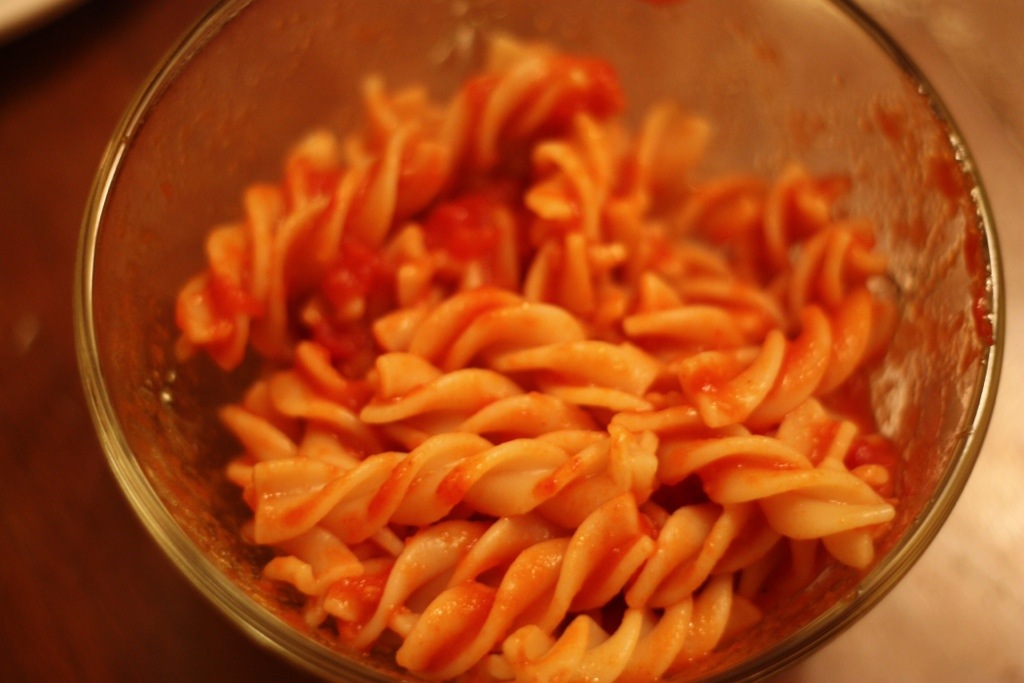A Basic, Yet Superbly Tasty, Marinara Sauce
 In late January, the New York Times published a recipe for a basic marinara sauce in their Dining section along with a very interesting article. I will admit (to eye rolls and audible gasps, I'm certain!) that I'm not a huge fan of pasta meals. A pasta only dinner leaves me feeling uncomfortably full and bloated, yet hungry within a few hours. Don't misunderstand, though. I do love a few bites or a small bowl of good pasta, but it needs to be paired with something else like a piece of grilled fish or a big, interesting salad. So, while one of my least favorite meals is a heaping plate of pasta, one of my most dreamy meals would be a side portion of Palace Kitchen's "plin" a piedmontese style ravioli filled with roast pork and chard (one of my top 10 plates in Seattle- more on this list to come) paired with a piece of seared Pacific Northwest salmon.
In late January, the New York Times published a recipe for a basic marinara sauce in their Dining section along with a very interesting article. I will admit (to eye rolls and audible gasps, I'm certain!) that I'm not a huge fan of pasta meals. A pasta only dinner leaves me feeling uncomfortably full and bloated, yet hungry within a few hours. Don't misunderstand, though. I do love a few bites or a small bowl of good pasta, but it needs to be paired with something else like a piece of grilled fish or a big, interesting salad. So, while one of my least favorite meals is a heaping plate of pasta, one of my most dreamy meals would be a side portion of Palace Kitchen's "plin" a piedmontese style ravioli filled with roast pork and chard (one of my top 10 plates in Seattle- more on this list to come) paired with a piece of seared Pacific Northwest salmon.
When I do crave that taste of a good bite (or several...) of pasta, however, I'm always on the hunt for a go-to sauce. I like pesto sauce (here's another pesto recipe), but I've never quite nailed down a trusted marinara sauce...until now.

 This recipe is delightfully simple, yet full of complex flavor. The appeal of the recipe for me was the minimal list of ingredients, which prevents overcrowding and, instead, allows each ingredient to take center stage and how quick the sauce comes together. The first thing to know before approaching this recipe is that marinara is not synonymous with tomato sauce. Instead, marinara should taste like the brightness of a tomato paired with the richness of olive oil and a substantial hit of garlic, chili, and basil.
This recipe is delightfully simple, yet full of complex flavor. The appeal of the recipe for me was the minimal list of ingredients, which prevents overcrowding and, instead, allows each ingredient to take center stage and how quick the sauce comes together. The first thing to know before approaching this recipe is that marinara is not synonymous with tomato sauce. Instead, marinara should taste like the brightness of a tomato paired with the richness of olive oil and a substantial hit of garlic, chili, and basil.
I learned many things from making this beautiful, simple sauce. One important key to the recipe is to make this sauce in a skillet rather than a pot so that the flavors can integrate more easily and cook more quickly which prevents the tomato seeds from over cooking and producing a bitter flavor. Additionally, it is important to either thinly slice or lightly crush the garlic rather than mince it. The more the garlic cells are broken down, the more sulfurous molecules, which produce a strong odor and flavor, are released. The trick is a subtle, well developed flavor of garlic rather than something overwhelming. Another trick is to use the basil only for flavoring- remove it once the sauce is finished cooking. And, lastly, not to use onion or butter, this makes the sauce more authentically southern Italian.
Marinara Sauce
1/4 cup extra-virgin olive oil 7 garlic cloves, peeled and crushed 1 28-ounce can diced San Marzano tomatoes (I used the Trader Joe's brand) Small pinch of crushed red pepper flakes 1 teaspoon kosher salt 1 large fresh basil sprig
In a large skillet (do not use a deep pot) over medium heat, heat the oil. When it is hot, add the garlic. As soon as garlic is sizzling (do not let it brown), add the tomatoes straight from the can. Then, fill the can with 1 cup of water, slosh it around to get the reserved tomato juices, then pour the tomato water into the skillet. Add the red pepper flakes and salt. Stir. Place basil sprig, including stem, on the surface (like a flower)- I let Jack do this step which he thought was pretty cool. Let it wilt first, then submerge in sauce. Simmer sauce until thickened and oil on surface is a deep orange, about 15-20 minutes. Discard the basil, then toss with warm pasta to coat it, do not just place it on top of the noodles.
If you make it, I'd love to know what you think. Do you have any go-to pasta sauces I should try?
